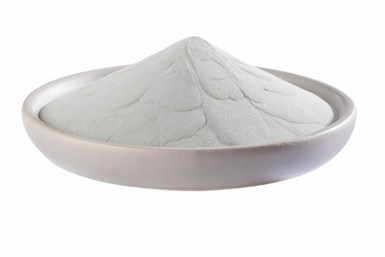Kennametal Develops First Stellite Powder for 3D Printing
Stellite 21 AM powder enables customers to achieve similar wear and corrosion resistance properties in additively manufactured parts.

Kennametal’s Stellite 21 powder for additive manufacturing offers wear and corrosion resistance.
Kennametal’s Stellite 21 AM powder is the first Stellite powder qualified for laser powder bed additive manufacturing (AM), and the latest addition to its portfolio of high-performance metal powders optimized for 3D printing.
The company says Stellite 21 AM powder offers the unique corrosion and wear-resistant properties of the Stellite alloy family for laser powder bed additive platforms, enabling the production of high-performance wear components.
The powder is designed to help users leverage the advantages of 3D printing and make better parts, faster and more efficiently. It is available direct to customers for use in their own 3D printing applications or in combination with Kennametal’s end-to-end additive production capabilities to make fully finished components.
Valued for its superior wear and corrosion resistance, the Stellite 21 alloy has a long history of success in traditional manufacturing applications in the oil and gas, power generation and aerospace industries. Stellite 21 AM powder now enables customers to achieve similar wear and corrosion resistance properties in additively manufactured parts. The alloy is well-suited for flow control applications and can be integrated into complex designs to mitigate cavitation, erosion or corrosion failures.
The powder’s composition features a Cobalt Chrome Molybdenum alloy matrix, containing dispersed hard carbides which strengthen the alloy and increase its hardness while decreasing the material’s ductility. It also has excellent corrosion and thermal shock and mechanical shock resistance, the company says.
Related Content
-
3D Printed Titanium Replaces Aluminum for Unmanned Aircraft Wing Splice: The Cool Parts Show #72
Rapid Plasma Deposition produces the near-net-shape preform for a newly designed wing splice for remotely piloted aircraft from General Atomics. The Cool Parts Show visits Norsk Titanium, where this part is made.
-
DMG MORI: Build Plate “Pucks” Cut Postprocessing Time by 80%
For spinal implants and other small 3D printed parts made through laser powder bed fusion, separate clampable units resting within the build plate provide for easy transfer to a CNC lathe.
-
How Norsk Titanium Is Scaling Up AM Production — and Employment — in New York State
New opportunities for part production via the company’s forging-like additive process are coming from the aerospace industry as well as a different sector, the semiconductor industry.














